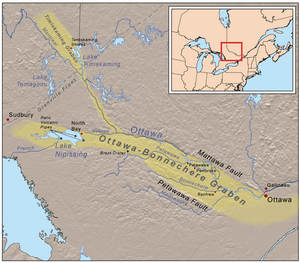Timiskaming Graben facts for kids
The Timiskaming Graben is a long, sunken area of land. It stretches about 400 km (250 mi) (250 miles) and is about 50 km (31 mi) (31 miles) wide. This geological feature crosses the border between Ontario and Quebec in Eastern Canada. It is connected to the Ottawa-Bonnechere Graben, which is a "failed arm" of the Saint Lawrence rift system. This rift system formed when the ancient Iapetus Ocean began to open up.
Contents
What is the Timiskaming Graben?
A graben is a special type of valley. It forms when a block of the Earth's crust drops down between two parallel faults. Think of it like a section of land sinking between two cracks in the ground. The Timiskaming Graben is a large example of this. It is a deep, sunken area that formed over millions of years.
How Did the Graben Form?
The Timiskaming Graben started to form a very long time ago, possibly as far back as 2.4 billion years ago. This happened when the Earth's crust in the area collapsed along two major cracks, called the Quinze Dam and Cross Lake faults.
Over time, the graben was reactivated, meaning it became active again. This happened during periods when the Earth's crust was pulling apart. This pulling apart is called extensional tectonics. It was linked to the breakups of ancient supercontinents like Rodinia and Pangaea. The graben also moved during times when the crust was pushing together, which is called compression. This pushing together created mountain ranges, like the Appalachian Mountains.
Lake Timiskaming and the Graben
Today, part of the Timiskaming Graben is filled by Lake Timiskaming. This lake is about 100 km (62 mi) (62 miles) long. It is what remains of a much larger ancient lake called glacial Lake Barlow. Lake Barlow drained away about 8,000 years ago, at the end of the last glacial period (Ice Age).
Earthquakes in the Graben
The Timiskaming Graben is an area where earthquakes happen. It is part of a larger region known as the Western Quebec Seismic Zone. When the old faults within the graben become active again, they can cause earthquakes. One famous example is the 1935 Timiskaming earthquake.


